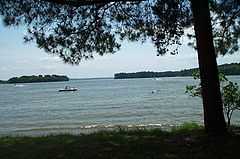Lake Livingston
| Lake Livingston | |
|---|---|
 | |
| Location | Polk, San Jacinto, Trinity and Walker Counties, Texas |
| Coordinates | 30°44′N 95°09′W / 30.74°N 95.15°WCoordinates: 30°44′N 95°09′W / 30.74°N 95.15°W |
| Type | reservoir |
| Primary inflows | Trinity River |
| Primary outflows | Trinity River |
| Catchment area | 16,616 sq mi (43,040 km2)[1] |
| Basin countries | United States |
| Max. length | 31 mi (50 km) |
| Max. width | 9 mi (14 km) |
| Surface area | 336 km² |
| Average depth | 23 ft (7.0 m) |
| Max. depth | 90 ft (27 m) |
| Water volume | 1,750,000 acre·ft (2.16 km3) |
| Shore length1 | over 450 mi (720 km) |
| Surface elevation | 131 ft (40 m) |
| Islands |
Alligator Island Pine Island |
| Settlements |
Onalaska Point Blank Riverside |
| References | [1] |
| 1 Shore length is not a well-defined measure. | |
Lake Livingston is a reservoir located in the East Texas Piney Woods. Lake Livingston was built, and is owned and operated, by the Trinity River Authority of Texas (TRA) under contract with the City of Houston for water supply purposes.[1] The lake is one of the largest lakes constructed for water supply purposes located totally within the State of Texas. Only the Sam Rayburn Reservoir is larger. The Livingston Dam, constructed across the Trinity River approximately 7 miles (11 km) southwest of the city of Livingston is 2.5 miles (4 km) in length and has an average depth of 55 feet (17 m).[2]
Construction

The lake construction was paid for by the sale of revenue bonds that were to be redeemed with income derived from the sale of water. The dam construction began in 1966 and was completed in 1969, by Forrest and Cotton, Incorporated. The cost to build the earthen dam was US$83,996,957.
Use
Water stored in the lake is used to supply industrial, municipal and agricultural needs in the lower Trinity River Basin and the Houston/Galveston metropolitan area. Its significance in the face of the extraordinary growth experienced by this region of the Upper Texas Gulf Coast is tremendous. A wide range of public and commercial recreation facilities including full service marinas, camping and motel accommodations are located along the shoreline. The City of Houston owns two-thirds of the water rights of the lake, with the other 1/3 remaining under control of the TRA.
The Lake
The earthfill dam has a concrete spillway and was designed by Brown and Root, Incorporated (the predecessor to the modern-day KBR). The dam has a spillway crest elevation of 99 feet (30 m) above mean sea level. The average base width of the Dam's earthen embankment is 310 feet (94 m) wide. The spillway is designed and constructed to pass flows of three times the maximum-recorded flow of the river at this site.[2]
Lake Livingston has a surface area of 83,000 acres (360 km²) and impounds 1,750,000 acre feet (2.16 km3) of water at its normal pool elevation of 131 feet (40 m) above mean sea level. The average depth of the lake is 23 feet (7 m) with a maximum depth of 90 feet (27 m). Lake Livingston has more than 450 miles (700 km) of shoreline extending into San Jacinto, Polk, Walker, and Trinity Counties.[2]
Flood control
Lake Livingston was built with no flood control capabilities/flood storage capabilities, and because of this all water entering the lake whether it be from rainfall or inflow, must exit the lake as increase intake occurs. Flow through the dam is controlled by 12 tainter gates in a concrete and steel spillway that has an average depth of 55 feet. Operations of the spillway mirror river flows, so within a relative short period of time of increase of river flow discharge is increased, and vice versa.
Hurricane Rita
On September 23, 2005, rain and winds from Hurricane Rita caused waves up to 4 feet (1 m) in height to pound against the Lake Livingston dam. As a result, 11,000 feet (3.4 km) of large protective stones, or riprap, was stripped from the upstream face of the dam. To repair the damage the Trinity River Authority lowered the lake's pool level by 4 feet to 127 feet, preventing any further erosion of the exposed earthen embankment. The Federal Emergency Management Agency (FEMA) and the City of Houston footed the $9.6 million repair bill and awarded the repair contract to Archer Western Contractors. Over the course of the repair movement of 72,215 tons of 32 inch rock in 3,183 truckloads and 15,808 tons of eight-inch (200 mm) bedding rock in 687 truckloads was required. The rock was mined from a quarry in Navarro County near Corsicana. Work was largely completed by April 28, 2006, but due to a severe drought in 2006, the lake's regular pool level was not reached until the spring of 2007.
Entertainment References
Lake Livingston was featured on the third episode of the first season of the television show, River Monsters, which airs on Animal Planet. The host, Jeremy Wade, was searching for alligator gar.[3]
See also
References
- ↑ 1.0 1.1 1.2 Lake Livingston from the Handbook of Texas Online. Retrieved 5 February 2007.
- ↑ 2.0 2.1 2.2 Trinity River Authority of Texas - Lake Livingston. Retrieved 5 February 2007.
- ↑
External links
- Trinity River Authority of Texas - Lake Livingston
- Trinity River Authority of Texas - Water supply
- Lake Livingston from the Handbook of Texas Online
- U.S. Geological Survey Geographic Names Information System: Lake Livingston
- Lake Livingston Home page -
- Experience Lake Livingston -